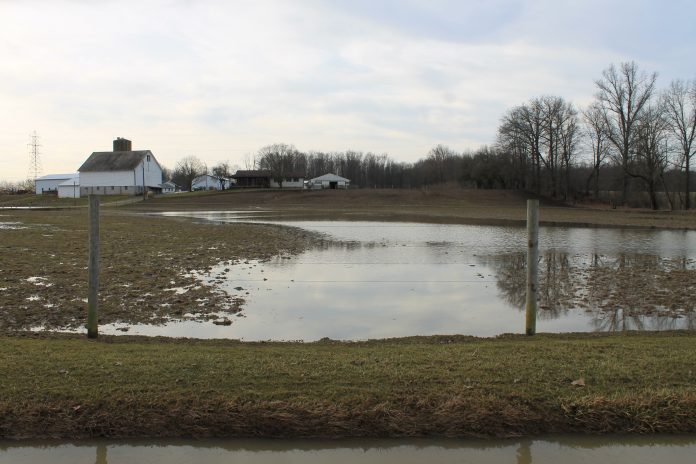The weather this winter in Eastern Ohio has been continuously changing. We go from extreme cold to hot, and then from snow to rain.
Last night I awoke to a torrential downpour of rain during the night. On my way to work this morning I witnessed the effects that the rain had.
For one, it melted the remaining snow that had accumulated. Second, it created high water and in some places widespread flooding.
Actually, in the five years that I have worked in Carroll County, this is the highest I have seen the water. I saw a lot of land that is used for pasture during the summer and fall covered with flood waters.
Therefore, I decided to write this week about the recovery of pastures after flooding.
High water and flooding events will vary in the degree of impacts and damage that they have on pastures. Damage will depend on how the flood flowed across the pasture, the various soil types involved, water table levels and a host of other factors.
Damages
Water cover, by itself, is not the only degree of pasture damage that can occur.
Other factors including soil texture and drainage, speed of water flow, water quality and depth all contribute in varying degrees of how a pasture can become damaged after flooding.
The longer a pasture is under water, the greater potential for water and flood damage. Light soils that drain fast will allow for a speedy pasture recovery. While heavy soils will hold water for a longer period of time after the flood water has receded.
Providing the flooding has not caused the soil to erode, the quicker the water flows, the better the pasture recovery. The slower the water flows, the more sedimentation and the slower the recovery.
In some instances, sediments can be too deep and can restrict plant growth during the growing season.
Another problem with the sediment is that it can contain weed seeds and other undesirable plants.
Areas covered by flood waters should be monitored closely for weeds during the growing season and managed to rid the area of weeds and replant desirable pasture grasses in those areas.
Flooding may also impact the fertility of the soil in the pasture, as some nutrients may have been leached. Pastures may need to be soil tested after flooding events to reevaluate soil fertility in flooded areas.
Reentry
Flood recovery can be a daunting task, so there are other things to consider before allowing livestock into previously flooded pastures.
Flood waters carry debris of every shape, size and material.
This can include pieces of metal, wire fencing, electrical wire, boards with nails, pipe, plastic, foam, appliances, trees, and other dangerous debris such as gas cans, propane tanks, batteries, biological waste, garbage and even dead fish and animals.
Livestock can be injured from all of these things so it is important to remove all of the debris before allowing livestock on to those pastures.
Another important thing is to keep livestock away from areas that were flooded in the pasture until the ground is dried out and solid again. Not only can livestock damage plants by trampling wet soil, they can also cause soil compaction that can have long-term complications and slow down pasture recovery.
Related diseases
After flooding, producers should take special precautions against livestock flood-related accidents and diseases. Be on the watch for symptoms of flood-related diseases such as lameness, fever and swelling.
Remember that water-borne diseases can be present in flooded areas for months following the flood. There can be increased risks of infectious diseases such as pneumonia, leptospirosis and blackleg just to name a few.
Livestock that were exposed to flooded areas during, or immediately after, the flood event should be vaccinated for clostridial diseases, including tetanus.
It is very important to closely inspect all livestock that were exposed to flooded areas for injuries.
I would like to say that today’s flooding event will be the last one before we turn livestock out to pasture for the summer, but we all know that would be a lie.
There will be more rain events with different degrees of high water throughout the spring months. But we all need to remember that pasture recovery includes assessing grass and soil damages and making a plan to correct and improve them.
Removing debris and fixing fence is only a small part of pasture damage recovery after the flooding.













